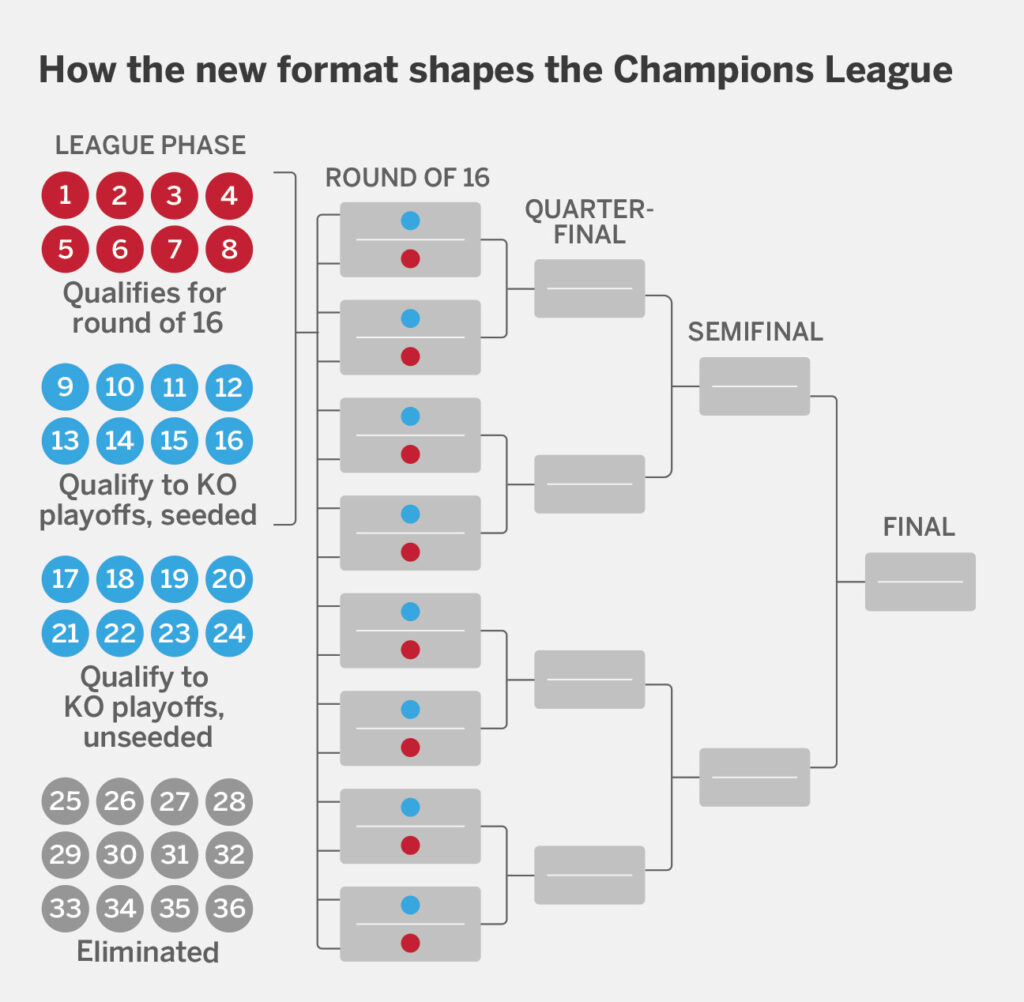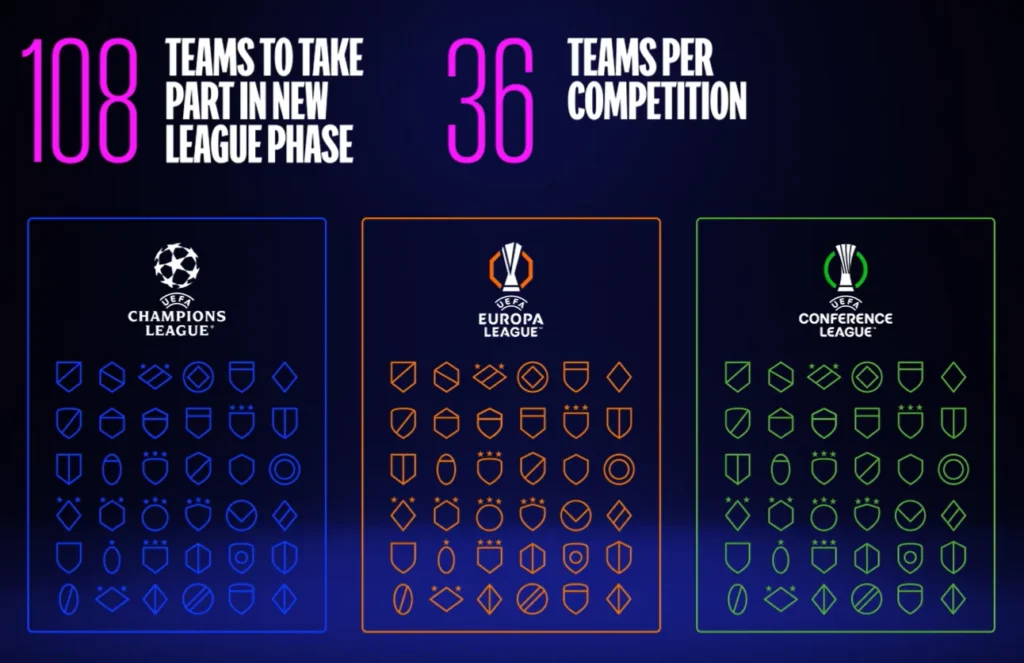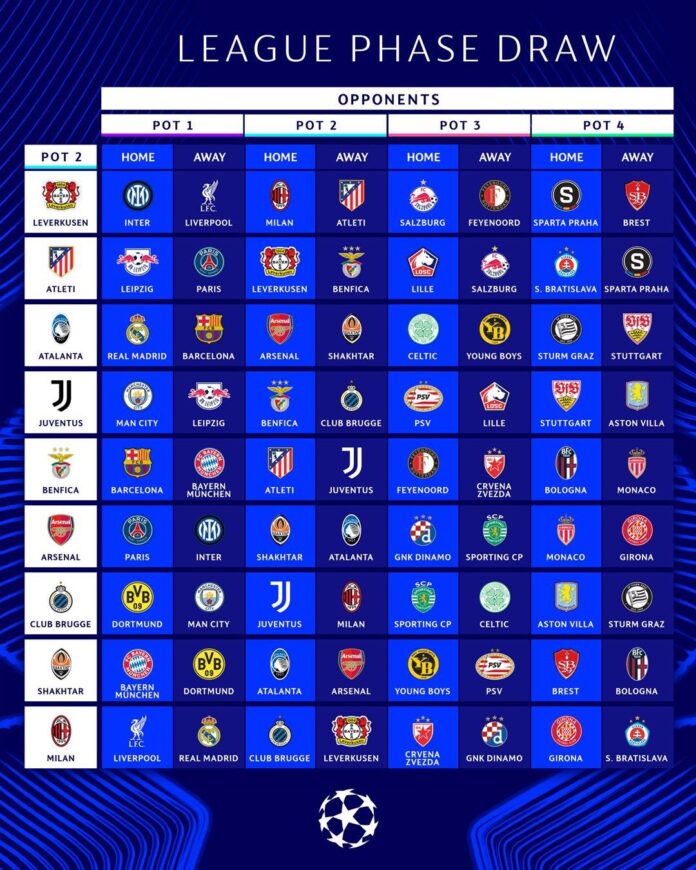Table of Contents
The question, “how many games in Champions League,” is about to get a whole new answer starting in the 2024/2025 season! UEFA has announced an exciting new format that changes everything fans thought they knew about this prestigious tournament. With 36 teams in one big league table, every game will matter more than ever.
In this updated format, each team will play eight matches in the league stage. Four will be home games, and four will be away games, but they won’t play the same opponent twice. After this, the top eight teams move straight to the knockout rounds, while others fight for their chance to stay in the tournament. Let’s explore how this works and why it’s such a big deal for football lovers.
What’s New in the 2024 Champions League Format?
Big changes are coming to the Champions League! Starting from the 2024/2025 season, the format will be different from what fans know today. Instead of having eight groups with four teams, there will now be 36 teams competing in a single league table. This is a move to make the tournament more inclusive and exciting for everyone.
Every team will play eight matches in the league stage. These games will be against eight different opponents, with four played at home and four played away. There will no longer be back-to-back games with the same team during the league stage, which keeps the competition fresh and unpredictable.
UEFA’s decision to create a single league aims to increase the number of top-level games early in the season. This means fans could see big matches like Manchester City vs. Real Madrid or Bayern Munich vs. Barcelona right from the start.

How Many Games in Champions League Under the Swiss Model?
The Swiss model is at the heart of the new Champions League format. Each of the 36 teams will play eight games in the league phase, with every match counting toward their place in the standings. This approach ensures that no game is meaningless.
After the league phase, the top eight teams will directly enter the knockout stage. Teams ranked 9th to 24th will compete in an extra round to fight for a spot in the knockout rounds. Meanwhile, teams ranked 25th to 36th will exit the competition.
This format encourages a competitive balance by matching teams with opponents of similar skill levels. Fans can expect thrilling matchups throughout the season as every game contributes to the rankings.
Why 36 Teams Make a Difference in the Champions League
Adding four more teams to the Champions League lineup might not sound like a big deal, but it is. These extra slots give smaller clubs a chance to compete on the big stage, something that was much harder before.
In the past, teams from less famous leagues rarely made it into the Champions League. With 36 spots available, clubs from all over Europe can now participate, promoting diversity in the tournament. This makes the Champions League more representative of European football as a whole.
For fans, this means discovering new teams and players they might not have followed before. It’s also a fantastic opportunity for underdog clubs to shine and create unforgettable moments.
What Happens After the League Phase?
The league phase is just the beginning. After all 36 teams have played their eight matches, the real excitement starts. The top eight teams from the league standings will advance straight to the knockout rounds.
For the teams ranked 9th to 24th, there’s an extra round to battle for a spot in the round of 16. This knockout phase play-off is crucial because only eight out of these 16 teams will move forward.
Teams in the knockout stages will be matched based on their league rankings. Higher-ranked teams get the advantage of playing the second leg at home. From this point, the tournament follows the traditional knockout format until a champion is crowned.
Knockout Stages: A Closer Look at the New Rules
The knockout rounds in the new format will include:
- Direct qualification for the top 8 league-phase teams.
- A play-off round for teams ranked 9th to 24th.
- Home advantage for higher-seeded teams in the play-off phase.
The round of 16 will pair play-off winners with top-eight teams. From here, it’s a familiar path to the quarter-finals, semi-finals, and the grand final. Every match is crucial, and the stakes are higher than ever.

Conclusion
The new Champions League format answers the question “how many games in Champions League” in a fresh and exciting way. With 36 teams and a Swiss model league phase, the tournament offers more thrilling matches and opportunities for diverse clubs to shine.
For fans, this means a more inclusive and competitive Champions League. With every game counting and new teams joining the mix, the excitement of European football is about to reach new heights.
FAQs
Q: How many games does each team play in the league phase?
A: Each team plays eight matches in the league phase.
Q: What happens to teams ranked 25th to 36th after the league phase?
A: These teams are eliminated and do not proceed to the knockout stages or Europa League.
Q: When does the new Champions League format start?
A: The new format begins in the 2024/2025 season.
Q: How are teams ranked in the league phase?
A: Teams are ranked based on their performance in the eight league matches.

